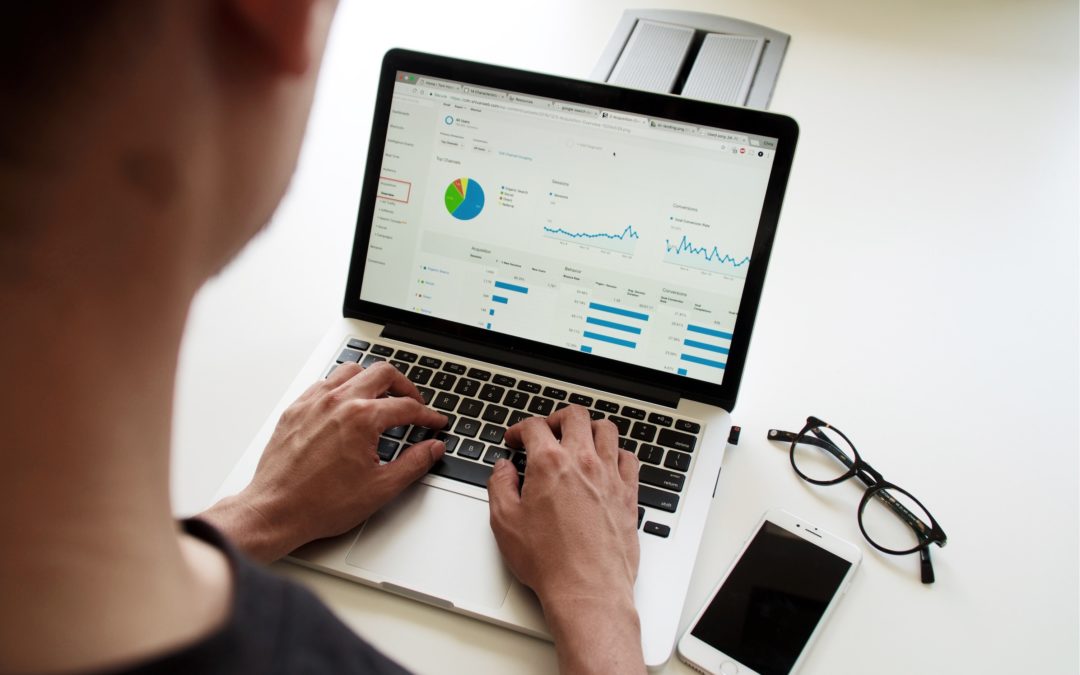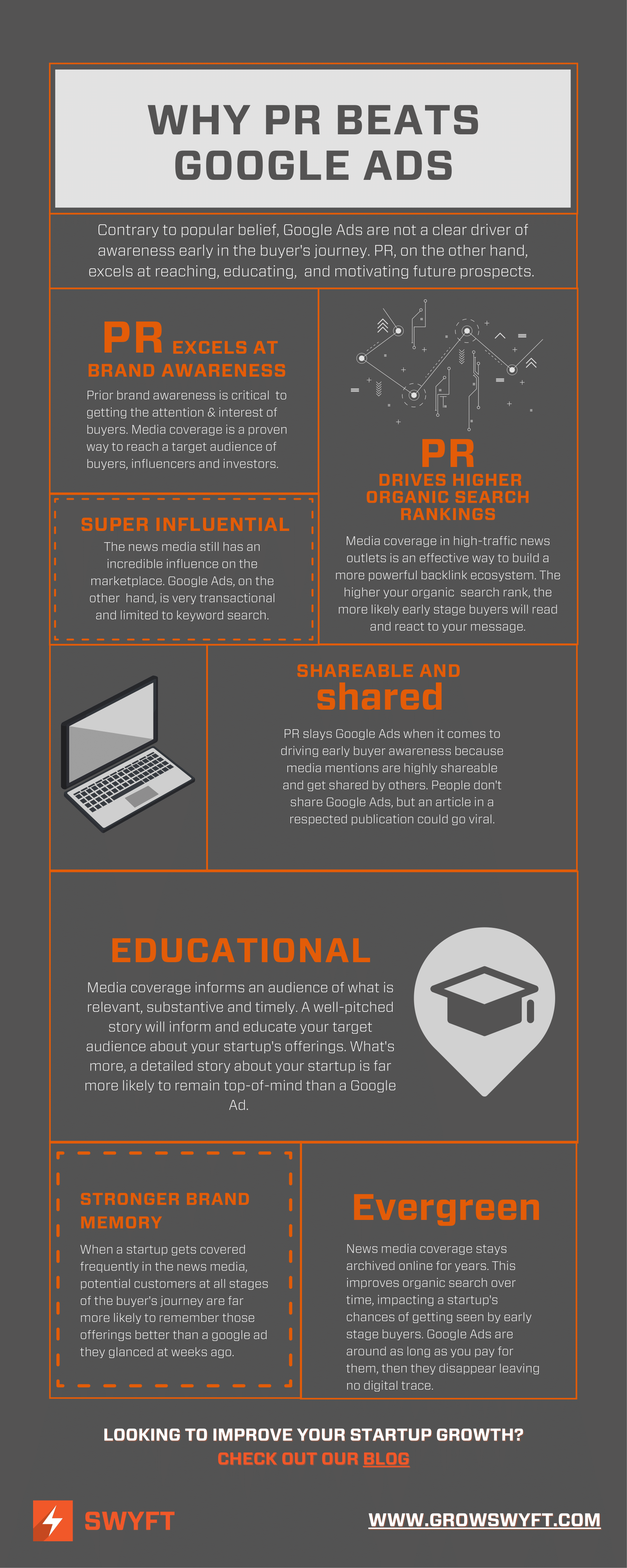Google Ads’ ability to drive results in the form of click-throughs and future lead conversion is not in dispute. Google Ads is commonly seen as effective at driving leads among potential buyers that are already showing purchase intent.
What is open to debate, however, is the general quality of the results of Google Ad campaigns (i.e., are they consistent with your ICP?). Also open to debate is whether Google Ads has presented your brand at the start of the buyer’s journey or later in the game, when some buyers may already have narrowed their options down.
Google Ad campaigns, contrary to popular belief, are also not a clear driver of lead attribution, even though a click-through may be the first way a given buyer lands on the website. There are far many other ways buyers can come across content related to a startup’s product, not the least of which is earned media in the form articles and dynamic content published in reputable news outlets.
Here are seven ways in which PR actually beats Google Ads when it comes to driving awareness early in the buyer’s journey.
PR excels as brand awareness
Prior brand awareness of a startup is one of the primary contributing factors to future buyers hearing about your new offerings. If they have heard about you and your brand made a strong enough impression, then it’s more likely the buyer will recall you when they start to realize they have a problem and begin to research possible solutions.
PR is arguably the undisputed champion of raising awareness about a startup and its offerings. That’s because media coverage is consumed much more broadly and readily by potential buyers than any form of owned or paid marketing a startup can concoct. Startup funding rounds, be they seed or later stage capital raises, always get the attention of busy journalists at Crunchbase, TechCrunch and VentureBeat. Product launches and major customer wins are favorite topics of interest among tech vertical news outlets as they relate directly to their audience.
PR drives higher organic search rankings
With nearly 80% of users preferring organic search results to paid according to a recent HubSpot report, a startup stands a much better chance of getting clicks from potential buyers if they rank high for keywords relevant to their offering. What’s one of the best ways to fuel a successful SEO strategy and grow organic traffic? PR!
PR is foundational to an effective backlinking strategy. Media coverage in reputable sites with high domain authority and relevant content to your startup checks all the right boxes for Google’s always changing search algorithm. Swyft wrote this article about how PR and, more specifically, thought leadership can help propel better SEO results than the usual content and backlinking games played for SEO firms.
The higher you rank for your industry’s competitive keywords, the better your chances of getting found by people at the start of their buyer’s journey, not at the middle or end as is often the case with Google Ad results.
Super influential
I’m not talking about ‘influencers’ that are commonly seen on social media platforms like Instagram and Facebook. Long before these influencers came on the scene, the news media provided a great deal of influence over the marketplace.
Back in the day when I worked at Dell, the company would mail early demos of its newest PC line to technology journalists like Walt Mossberg, who was the principal tech journalist for the Wall Street Journal from 1991 to 2013. His reviews would have a direct impact on the outcome of how a PC was received in the broader public because his readers trusted his knowledge and objectivity. Needless to say, brands like Dell would enjoy favorable sales on models he gave positive reviews, and gnashed their teeth when they received a less than stellar review by Walt.
The news media, whether more broad based like the WSJ or tech focused like TechCrunch, still has incredible influence on the reputation and revenue potential of startups. Whereas Google Ads is very transactional and limited to keyword search, media coverage spreads the word faster and drives demand for a startup’s offerings early and often in the buyer’s journey.
Shareable and shared
Another reason why PR kills Google Ads when it comes to driving early buyer journey awareness is because media mentions are highly shareable and get shared all the time.
When was the last time you saw someone share a Google Ad anywhere? It just doesn’t happen. But an article in Crunchbase or an influential tech vertical publication your target customers pay attention to will get shared in a variety of ways: LinkedIn, Twitter, media daily news emails, on the media outlet website. What’s more, when others see your news, they may turn around and share it with their network, giving your brand exponentially more reach and potential to reach future customers.
Finally, your startup can and should share its own media coverage. Everyone inside the company can share news clippings with their extended LinkedIn network, further amplifying reach and engagement well past the reach of the media outlet itself.
Educational
All media coverage informs its audience about what is relevant, timely and substantive. That means getting more media coverage, especially in tech trade publications, is designed to educate the media audience to what is new and different in the market.
If pitched to the right reporter, your product launch or major extension will get some coverage in niche verticals that are read by the very buyer audience you are targeting. The reporter will almost always give a detailed write-up that can inform and educate your target buyers and arm them with advanced knowledge about your startup. When they are ready to start looking for possible solutions to the problems your startup addresses, your brand will be top-of-mind or close to it — especially if you keep your PR outreach active over time.
Stronger brand memory
This concept builds upon everything I’ve written about above. When a startup gets covered in the news media and that coverage is seen by potential customers, those customers develop a heightened awareness about the startup’s offerings. That heightened awareness results in a more indelible memory that will come back to the customer much more quickly than a random Google Ad seen in a search weeks or even days ago.
The stronger a brand memory is the easier it is to recall when a buyer recognizes there is a problem that may need a solution. The time it takes to review and process media coverage, and the fact that it appears objective and authoritative, predisposes the buyer towards recalling your startup much more readily than random Google ads. In short, your target buyers are much more likely to engage with your brand if they’ve learned about you from frequent news media coverage.
Evergreen
One huge advantage PR and its resulting media coverage has over Google Ads is how media coverage stays archived on news media sites and continues to stay indexed by search engine algorithms. In short, organic earned news media has a much longer shelf life than Google Ads. Once a Google Ads campaign finishes, it’s gone, never to return or even show up in any search until you re-invest in an ad campaign at a later date.
Since startups don’t know when a target buyer will actually start researching for a solution to a problem, having evergreen content that ranks high in organic search is far more effective in the long run at winning top-of-funnel awareness and lead conversions.


